Investor sentiment towards precious metals is at the lowest level in over a decade. Many analysts believe the bull market is over and are calling for sub-$1,000 gold in 2014. Even diehard gold bugs are losing faith, as the correction has been longer and more severe than most had anticipated.
So, is it time to throw in the towel? Is the bull market in precious metals really over?
In order to answer this question, I thought it would be constructive to re-visit the fundamental drivers of the gold price and determine if anything changed over the past two years to weaken the bullish case. My conclusion is that nearly all of the fundamental factors that[amazon asin=162040236X&template=*lrc ad (right)] have been driving the gold price higher in the past decade have only strengthened in the past two years. Now that the correction has most likely run its course, I expect gold to rebound into the close of the year and bounce sharply higher in 2014. Here are the 12 reasons why…
#1 – Rapidly Growing Debt
Just one day after President Barack Obama signed into law a bipartisan deal to end the government shutdown and avoid default, the US debt surged a record $328 billion, the first day the government was able to borrow money. The U.S. national debt has increased by more than a trillion dollars in the past 12 months. This pushed the total debt above $17 trillion for the first time in history. As the debt increases and GDP growth slows, the debt-to-GDP ratio will continue to rise at an accelerating pace. This is simple math and it dictates an ongoing slide in the purchasing power of the dollar and rise in the purchasing power of real assets and particularly monetary metals such as gold and silver.
The following charts show the steepening rise in total public debt and the debt-to-GDP ratio of the United States. Many economists view a debt-to-GDP ratio of 100% as the point of no return. It is a slippery slope that is certain to push higher at an accelerated rate in the coming years.
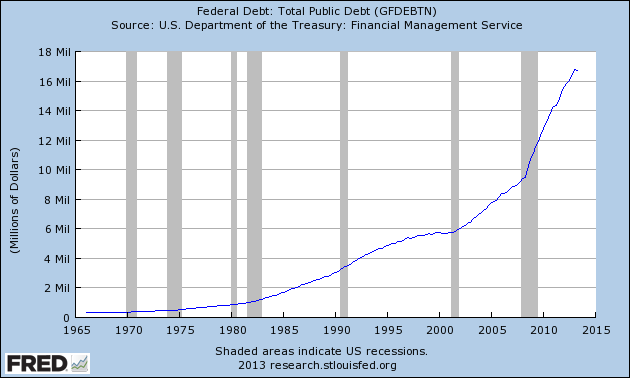
Note that alternate calculations of the total debt including unfunded liabilities and off-balance sheet items, puts the number somewhere closer to $100 trillion or more than 5 times the official figure. This equates to a debt-to-GDP ratio of over 500%, not the 100% charted below.
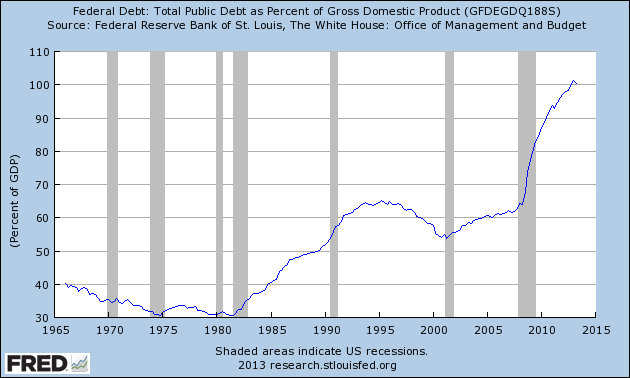
Takeaway: The total level of debt and the debt-to-GDP ratio have both increased substantially in the past two years. This is bullish for gold, as precious metals have a positive correlation to total debt levels.
#2 – Inept Government and Partisan Bickering
The fight over the budget and debt ceiling shut down the government for 16 days and ended up costing billions more than if the government would have remained open. Standard & Poors estimates that the 16-day government shutdown took $24 billion out of the U.S. economy, and reduced projected fourth-quarter GDP growth from 3 percent to 2.4 percent. Not only that, but it tarnished the image of U.S. financial strength and has many people worldwide questioning how the United States will continue to pay its bills. These shenanigans also led Fitch to put the U.S. on “rating watch negative” and the Chinese ratings firm, Dagong, formally downgraded its rating of the US from A to A-.
Both sides of the political aisle continue to engage in deficit spending and neither side seems serious about addressing the debt and deficit. Sadly, my guess is that they will never voluntarily reduce spending and will have to be forced to do so via default or other events. The more they shine a light on the fiscal weakness of the U.S., the faster other nations dump U.S. debt and the sooner we will see the inevitable ratings downgrade and debt default (official or via hyperinflation).
Takeaway: The Western political system is broken and the idiots running the U.S. government severely damaged government [amazon asin=B004I08GIQ&template=*lrc ad (right)]credibility and brought the country dangerously close to a technical default. They haven’t made any serious effort to balance the budget and their “solution” only kicks the can down the road for a few more months. Look for more of the same in the near future, which will further erode the creditworthiness of the U.S. government and faith in the U.S. dollar. This increases the bullish outlook for gold.
#3 – QE to Infinity Confirmed, as FED Balance Sheet Explodes
At Gold Stock Bull, we have long been calling QE3, “QE to Infinity” and doubting that any major tapering would occur. With weak economic growth and low official inflation, the FED’s dual mandates would dictate more stimulus, not less. Just weeks ago there was a consensus for tapering in September. Now, analysts are talking about March of 2014 at the earliest. My expectation is that they will change the QE program, maybe give it a different name, but the end result will always be a net increase in stimulus efforts.
The FED’s balance sheet has already increased from $869 billion in August of 2007 to $3.8 trillion today! The nomination of Janet Yellen as FED chief adds gasoline to the fire, as she is expected to be at least as accommodative as her predecessor and potentially much looser with the printing press. Helicopter Yellen?
Takeaway: The economy is addicted to QE and reliant on central bank stimulus to stay afloat. The world now understands that the FED cannot end the bond-buying program and has no intention of doing so anytime soon. If anything, we are likely to see increased quantitative easing in the future, just as a drug addict must up their dosage in order to have the same impact. This monetization of debt increases the bullish outlook on gold, as the gold price has historically trended higher along with the FED balance sheet.
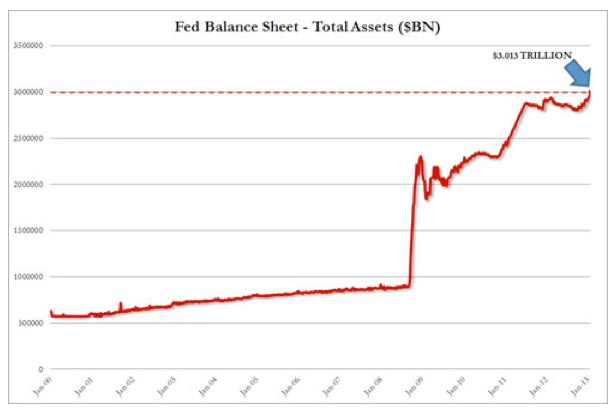
#4 – Dollar Losing Status as World Reserve Currency
The exorbitant privilege of being able to print the world reserve currency is coming to end. “It is perhaps a good time for the befuddled world to start considering building a de-Americanized world,” said a statement on Monday by Xinhua, the state news agency of China — which holds some $1.3 trillion in Treasury bonds.
“The United States will inevitably lose its reserve currency monopoly,” wrote economists Hélène Rey of the London Business School, Pierre-Olivier Gourinchas of the University of California, Berkeley, and Emmanuel Farhi of Harvard University. “It can only be a [amazon asin=B001IAT70A&template=*lrc ad (right)]matter of time before the world becomes multipolar.” The IMF echoed this sentiment, stating how “reserves concentration in the government debt of one country introduces idiosyncratic risks to the international monetary system.”
Several nations now have bi-lateral trade agreements that bypass the dollar. China has made arrangements to swap Yuan’s for for local currencies with Japan, Russia, Australia, Iceland, South Korea, Malaysia, Brazil, India and South Africa. The BRICS nations are emerging as a powerful economic force and they are intent on conducting affairs without use of the U.S. dollar. The growing rift with Saudi Arabia also threatens the petrodollar.
Oil-rich countries that have attempted to sell their oil in currencies other than dollars include Iraq and Libya, both bombed into submission. Iran is now trading oil for gold, bypassing the U.S. petrodollar. This is likely the real reason they are now in the crosshairs of the U.S. military. Syria is seen as a stepping stone to attacking Iran, but widespread opposition from ally countries and citizens alike stopped the recent war momentum.
As the influence of the petrol-dollar continue to wane, so too will the power of the U.S. dollar as the world reserve currency. Without the ability to deficit spend and export our inflation, it will come home to roost and the dollar will suffer or even collapse as have other debt-ridden fiat currencies throughout history.
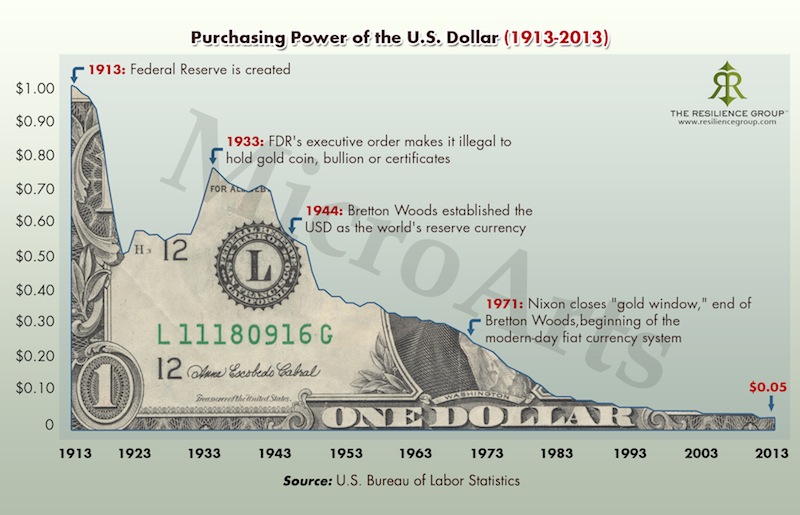
Takeaway: The dollar historically has an inverse relationship to gold. As the dollar continues to lose its role as world reserve currency and its purchasing power declines, the gold price will move higher. Mike Maloney and other analysts have calculated that the gold price needs to climb past $15,000 per ounce to account for all of the paper dollars that exist today. As more and more money is printed and debt is monetized, this target price only increases.
#5 – Global Race to Debase
It is not only the U.S. central bank that is printing money with wreckless abandon. Around the globe, central banks are trying to remain competitive in foreign trade by debasing their currency in line with the dollar. No countries are willing to admit it, but the currency war is on. As the competition heats up, they will no doubt overstep in their push to print money. This will translate into higher gold prices worldwide, measured across multiple currencies.
Takeaway: The race to debase has only intensified in the past few years, as evidenced by new stimulus programs in Europe and [amazon asin=B005P12F2K&template=*lrc ad (right)]Abenomics in Japan. Put simply, the more fiat money that is created in this currency war, the higher the price of gold and other commodities will climb.
#6 – Inflation Will Pick Up as Velocity of Money Accelerates
Up until this point, a large portion of the new money printed since the financial crisis has been parked with the banks or as excess reserves with the FED. Banks are reluctant to lend and corporations are also hoarding cash. Individuals are consuming less, tightening their budgets amidst high unemployment and stagnant wages and paying down debt. This means that money has not been circulating throughout the economy at a very fast pace. The stimulus has disproportionately benefited banks and the wealthiest people in society, doing little for the middle class that continues to get squeezed.
To get money flowing, future stimulus efforts must be focused on tax breaks or refunds for the working class, who are more likely to spend that money into the economy than the rich that aren’t living near the margin. With unemployment higher than desired and official inflation lower than desired, I think we will see Yellen and the FED focus more on consumer stimulus now that the banks finances have been shored up. This will lead to a sharp increase in the velocity of money and when multiplied by all of the money created in the last few years, it could lead to high inflation or even hyperinflation if the FED fails to soak up the excess liquidity in time.
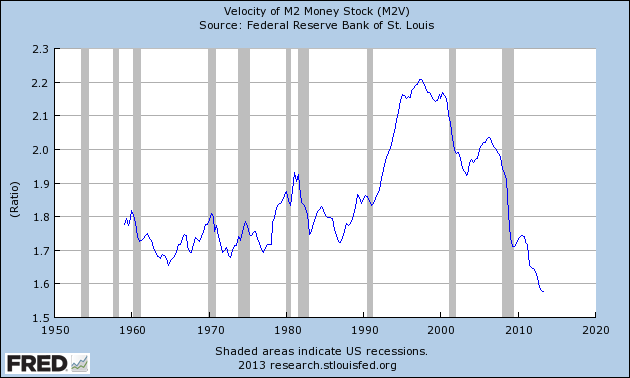
Takeaway: An increase in the inflation rate, driven by an increase in the velocity of money, will be very bullish for gold.



